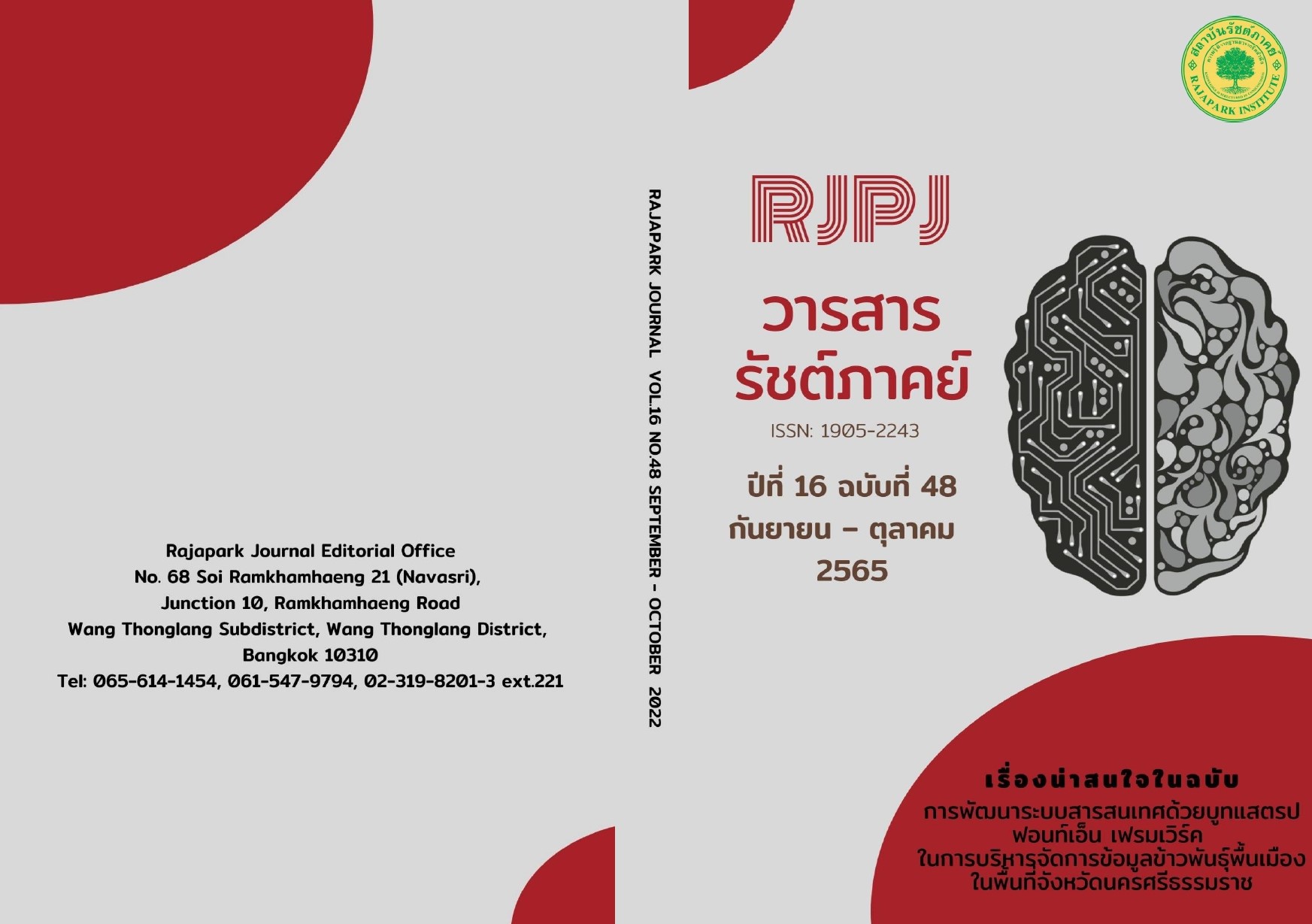ผลกระทบของประเทศไทยจากองค์กรพัฒนาเอกชนที่มีต่อการลงทุนโครงสร้างพื้นฐาน จีน-เมียนมา
Main Article Content
บทคัดย่อ
การวิจัยครั้งนี้วัตถุประสงค์เพื่อศึกษาข้อมูลพื้นฐาน องค์ประกอบสำคัญ และปัญหาและอุปสรรคที่เกี่ยวข้อง กับนโยบายการลงทุนโครงสร้างพื้นฐานจีน-เมียนมา และศึกษาผลกระทบที่มีต่อประเทศไทยจากกลุ่มองค์กรพัฒนา เอกชนในการขยายการลงทุนโครงสร้างพื้นฐานจีน-เมียนมา โดยเป็นการวิจัยเชิงคุณภาพ เครื่องมือที่ใช้ในการวิจัยโดยการทบทวนวรรณกรรมจากเอกสารบทความและตำราต่าง ๆ ร่วมกับการสัมภาษณ์เชิงลึกกับผู้ให้ข้อมูลสำคัญ 15 ท่าน และการแบบสนทนากลุ่มกับผู้ทรงคุณวุฒิ 12 ท่าน ซึ่งผู้ให้ข้อมูลสำคัญ ประกอบด้วย กลุ่มผู้กำหนดนโยบาย กลุ่มผู้นำนโยบายไปสู่การปฏิบัติในพื้นที่และกลุ่มบุคคลที่เกี่ยวข้อง 15 คน และนำข้อมูลจากการสัมภาษณ์มาวิเคราะห์เชิงเนื้อหา ผลการวิจัยพบว่า จีนมีการลงทุนมากมายในเมียนมา ประกอบด้วย การสร้างระเบียงเศรษฐกิจระหว่างประเทศตามโครงการหนึ่งแถบหนึ่งเส้นทาง แม้ว่าจีนจะลงทุนอย่างมหาศาล โดยครอบคลุมเส้นทางคมนาคมไปทางตอนใต้ของจีนเชื่อมต่อกับเมียนมา แต่กลยุทธ์การขยายการลงทุนโครงสร้างพื้นฐานระหว่างจีนและเมียนมา ยังไม่ประสบความสำเร็จเท่าที่ควรโดยเส้นทางที่เชื่อมระหว่างจีนกับท่าเรือน้ำลึกเจียวเพียว (Kyaukpyu) เพื่อออกสู่ทะเลอันดามัน เผชิญอุปสรรคหลายอันเกิดจากบทบาทขององค์กรพัฒนาเอกชน การเมืองภายในของเมียนมา ปัญหาด้านสิทธิมนุษยชนและปัญหาด้านสิ่งแวดล้อม ซึ่งส่งผลให้เกิดผลกระทบในเชิงบวกและเชิงลบต่อประเทศไทย ผลกระทบเชิงบวกที่สำคัญคือ จีนเป็นประเทศที่มีขนาดใหญ่มีพื้นฐานทางการเมืองและศักยภาพในการบริหารจัดการที่ดี อีกทั้งมีความสัมพันธ์อันดีกับไทยมายาวนาน ทั้งเรื่องชาติพันธุ์และทัศนคติ จึงเป็นโอกาสของไทยที่สามารถจะขยายการลงทุนเพิ่มขึ้น ส่วนผลกระทบเชิงลบคือ ความขัดแย้งกันระหว่างกลุ่มชาติพันธุ์ในเมียนมา รวมทั้งระหว่างรัฐบาลกองทัพ กับชนกลุ่มต่าง ๆ ทำให้ไทยต้องแบกรับปัญหาการอพยพค่อนข้างมาก
Article Details

อนุญาตภายใต้เงื่อนไข Creative Commons Attribution-NonCommercial-NoDerivatives 4.0 International License.
ทัศนะและความคิดเห็นที่ปรากฏในวารสาร ถือเป็นความรับผิดชอบของผู้เขียนบทความนั้น และไม่ถือเป็นทัศนะและความรับผิดชอบของกองบรรณาธิการ
เอกสารอ้างอิง
Amnuaykanchanasin, A. (2021). Political Unrest in Myanmar with the Thai Economy and Industry. Office of Industrial Economics. https://www.oie.go.th/assets/portals/1/fileups/2/files/ArticlesAnalysis/Myanmar_and_the_economy.pdf
Arase, D. (2015). China’s Two Silk Road Initiative: What It Means for Southeast Asia. Southeast Asia Affairs, 25-45. https://muse.jhu.edu/article/583040
ASEAN and Asia Studies Center. (2019). Research Integration Plan on Research and Innovation for Social and Environmental Development in Terms of Distribution of Prosperity and Livable Cities in Thailand and the Mekong Particle Group for Regional Development: The Context of NGOs Affecting China’s Expansion of Land and Water Infrastructure Investments According
to Policy on Routes to the South of China. Sustainable Development and Sufficiency Economy Studies Center, National Institute of Development Administration: SuDSESC.
Charassangsomboon, B. (2019). Financial Cooperation under the Belt and Road Initiative: Implications on Thailand’s Economic Security. The National Defence College of Thailand Journal, 61(1), 28-44.
https://so05.tci-thaijo.org/index.php/ratthapirak/article/view/188930
Charoenwadhanasuk, S. (2017). One Belt One Road (OBOR). http://www.dsdw2016.dsdw.go.th/doc_pr/ndc_2560-2561/PDF /m8574/8574%E0%B8%9E%E0%B8%A5.%E0%B8%A3.%E0%B8%95.%E0%B8%AA%E0%B8%B8%E0%B8%A3%E0%B8%9E%E0%B8%87%E0%B8%A8%E0%B9%8C%E0%B9%80%E0%B8%88%E0%B8%A3%E0%B8%B4%E0%B8%8D%E0%B8%A7%E0%B8%B1%E0%B8%92%E0%B8%99.pdf
Keawbutdee, P., Amjui, S., & Detjit, A. (2021). Globalization Leadership. The Journal of Research and Academics, 4(2), 283-296.
Meeboonlue, J., & Peebua, P. (n.d.). Rohingya Problems and Solutions. Strategic Studies Center, The National Defence Studies Institute. https://www.sscthailand.org/uploads_ssc/rhohingya.pdf
Ministry of Labor. (2022). Operations of Foreign NGOs in Thailand. https://www.doe.go.th/Prd/NGO/General/Param/Site/172/Cat/27/Sub/0/Pull/Singleview/View/Detail/Object_ID/563
Munkhong, A., & Rachathani, A. (2017). The Shift in the Trigger and its Impact on the Community in the Case of Ban Hua Wiang, Chiang Khong District, Chiang Rai Province. http://www.mekongci.org/images/work-mekong/report-kai.pdf
Salika. (2019, Dec. 19). NGOs: Origin and Change. SALIKA. www.salika.co/2019/12/21/Ngos-have-been-changed/
Satchanan, S. (2015, Dec. 10). China’s Role in Myanmar. ASEAN Insight, Bangkokbiznews.
https://www.bangkokbiznews.com/blogs/columnist/111256
Sukdanont, S. (2019). The Effects and Trends of the New Silk Road Development in the 21st Century. CUTI. http://www.cuti.chula.ac.th/articles/494/
Thitanon, B., Jarayabhand, P., & Jarusombat, S. (2022). The Solution of Rohingya Refugee in the Maritime National Security Dimension. RTNA Journal of Social Sciences, Humanities and Education, 9(1). 131-144. https://so06.tci-thaijo.org/index.php/rtna-socialj/article/view/252545
Thongtakorn, C., & Niyomthai, S. (2018). Analysis of China’s 21st Century Silk Road Policy. Thai Journal of Public Administration, 6(1), 95-126. https://so05.tci-thaijo.org/index.php/pajournal/article/download/137328/102231/364163


